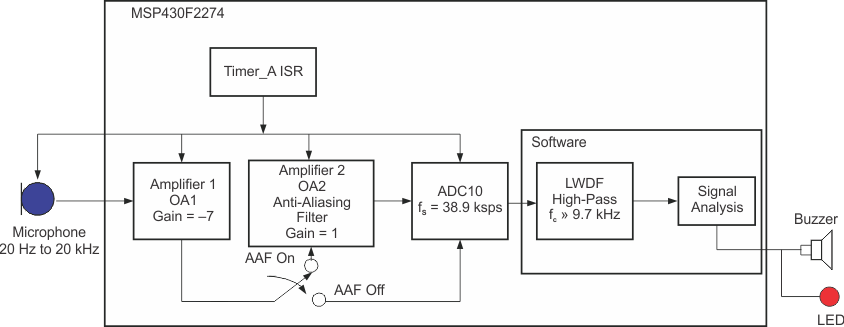SLAA351A April 2007 – November 2018 MSP430F2232 , MSP430F2232 , MSP430F2234 , MSP430F2234 , MSP430F2252 , MSP430F2252 , MSP430F2254 , MSP430F2254 , MSP430F2272 , MSP430F2272 , MSP430F2274 , MSP430F2274
2.1 Device Specifications
The MSP430F2274 is a 16-bit microcontroller (MCU) from the 2xx family of the ultra-low-power MSP430™ family of devices from Texas Instruments.[1][2] The supply voltage required for the microcontroller spans a broad range of 1.8 V to 3.6 V. The MCU operates at frequencies up to 16 MHz. The CPU has a 16-bit RISC architecture with a total of 51 instructions (27 core and 24 emulated). It supports a single-cycle shift and single-cycle add and subtract instructions. This enables efficient multiplication in the absence of a hardware multiplier.[4] The MCU also has an internal very-low-power low-frequency oscillator (VLO) that operates at 12 kHz at room temperature. This oscillator eliminates the need for an external onboard crystal for the operation of the device. However, an option has been provided on the board to use extermal crystal/resonators of up to 16 MHz. The MCU has two 16-bit timers (Timer_A and Timer_B), each with three capture/compare registers. An integrated 10-bit analog-to-digital converter (ADC10) supports conversion rates of up to 200 kilo-samples per second (ksps). The ADC10 can be configured to work with to on-chip operational amplifiers (OA0 and OA1) for analog input signal conditioning. The memory model supports up to 32KB of flash memory and 1KB of RAM in addition to 256 bytes of information memory. This device comes with four 8-bit I/O ports that can be used to control external devices. The current consumption of 0.7 µA during standby mode and active mode current of 250 µA at 1 MHz make this device an excellent choice for battery-powered applications.
Figure 1 shows the setup for the glass-breakage detector using this device.
 Figure 1. Setup for Glass-Breakage Detector Using MSP430F2274
Figure 1. Setup for Glass-Breakage Detector Using MSP430F2274 The microphone captures the analog input, and a buzzer or LED indicates detection of glass breakage. The op amps internal to the MSP430 MCU are connected to a few external passive components as part of the design of active analog filters.